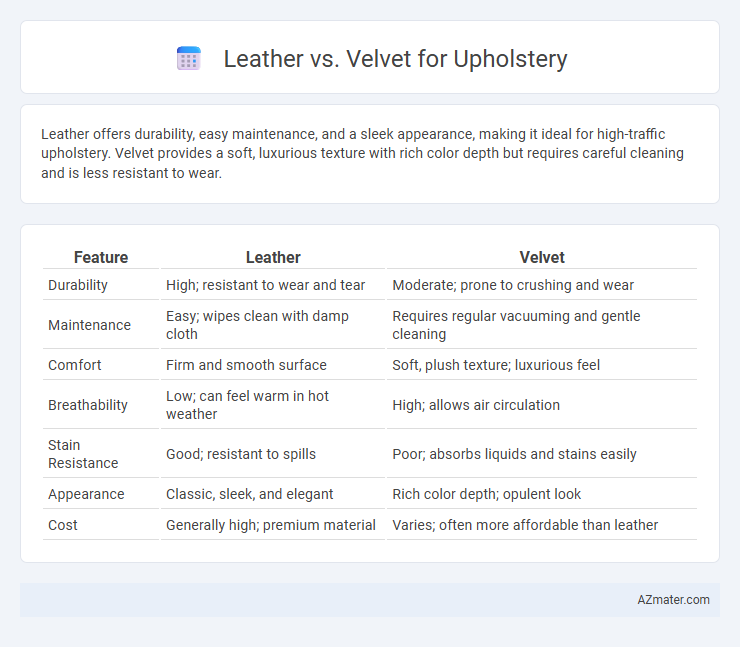Leather offers durability, easy maintenance, and a sleek appearance, making it ideal for high-traffic upholstery. Velvet provides a soft, luxurious texture with rich color depth but requires careful cleaning and is less resistant to wear.
Table of Comparison
| Feature | Leather | Velvet |
|---|---|---|
| Durability | High; resistant to wear and tear | Moderate; prone to crushing and wear |
| Maintenance | Easy; wipes clean with damp cloth | Requires regular vacuuming and gentle cleaning |
| Comfort | Firm and smooth surface | Soft, plush texture; luxurious feel |
| Breathability | Low; can feel warm in hot weather | High; allows air circulation |
| Stain Resistance | Good; resistant to spills | Poor; absorbs liquids and stains easily |
| Appearance | Classic, sleek, and elegant | Rich color depth; opulent look |
| Cost | Generally high; premium material | Varies; often more affordable than leather |
Introduction: Leather vs Velvet Upholstery
Leather upholstery offers durability, easy maintenance, and a timeless, sophisticated appearance, making it ideal for high-traffic areas and modern interiors. Velvet upholstery provides a soft, luxurious texture and vibrant color options, enhancing comfort and elegance in living spaces. Choosing between leather and velvet depends on lifestyle needs, aesthetic preferences, and functional demands of the furniture.
Aesthetic Appeal: Style and Visual Impact
Leather upholstery exudes a timeless, luxurious aesthetic with its smooth texture and natural patina that deepens with age, offering a sleek, sophisticated look ideal for modern or classic interiors. Velvet upholstery provides a rich, plush visual impact with its soft pile and vibrant color range, creating an inviting, elegant atmosphere perfect for adding warmth and depth to living spaces. Both materials enhance style, with leather favoring a minimalist, durable appeal and velvet delivering a bold, tactile dimension to furniture design.
Comfort and Texture Comparison
Leather upholstery offers a smooth, cool surface with a firm texture that becomes more supple and develops a rich patina over time, enhancing comfort through durability and breathability. Velvet provides a soft, plush feel with a dense pile that adds warmth and luxury, delivering a cozy and inviting tactile experience. While leather excels in easy maintenance and longevity, velvet excels in softness and aesthetic depth, making each material uniquely suited for varying comfort preferences and design styles.
Durability and Longevity
Leather upholstery offers superior durability and longevity due to its resistance to wear, scratches, and stains, making it ideal for high-traffic areas. Velvet, while luxurious and soft, tends to show signs of wear more quickly, including fading and fabric pile crushing, especially under frequent use. Choosing leather ensures a longer-lasting, easy-to-maintain surface, whereas velvet requires more delicate care to preserve its appearance over time.
Maintenance and Cleaning Needs
Leather upholstery requires regular conditioning and gentle cleaning with a damp cloth to prevent cracking and fading, whereas velvet demands frequent vacuuming and professional cleaning to maintain its plush texture and prevent matting. Leather's resistance to stains and spills makes it easier to wipe clean, while velvet's delicate fibers can trap dust and dirt, necessitating more careful handling. Both materials benefit from prompt attention to spills, but leather tends to be more durable for busy households seeking low-maintenance options.
Stain and Spill Resistance
Leather upholstery offers superior stain and spill resistance due to its non-porous surface, making it easier to wipe clean and less likely to absorb liquids. Velvet, with its dense pile fabric, tends to absorb spills quickly, requiring immediate attention to prevent staining and potential damage. For high-traffic areas or households prone to spills, leather provides more durable and low-maintenance protection compared to velvet.
Allergy and Pet Friendliness
Leather upholstery is hypoallergenic, resistant to dust mites, pet dander, and other allergens, making it an excellent choice for allergy sufferers. Velvet, while soft and luxurious, tends to trap allergens and pet hair more easily, requiring frequent cleaning to maintain a healthy environment. Pet owners often prefer leather for its durability and ease of wiping away pet hair and stains, whereas velvet may show claws and fur wear more prominently.
Cost and Value for Money
Leather upholstery typically commands a higher upfront cost due to its durability and timeless appeal, making it a worthwhile long-term investment for high-traffic areas. Velvet, while generally more affordable initially, may require more frequent maintenance and replacement, potentially increasing overall expenses over time. Evaluating leather's longevity against velvet's cost-effectiveness helps determine the best value for money based on usage and aesthetic preference.
Suitability for Different Lifestyles
Leather upholstery offers exceptional durability and easy maintenance, making it ideal for high-traffic areas and homes with pets or children. Velvet provides a luxurious, soft texture suited for low-traffic spaces or formal living rooms where comfort and style take precedence. Choosing between leather and velvet depends on lifestyle needs such as wear resistance, stain management, and desired ambiance.
Final Verdict: Which Upholstery is Best?
Leather upholstery offers unmatched durability, easy maintenance, and a timeless, sophisticated look, making it ideal for high-traffic areas and households with pets or children. Velvet upholstery provides a luxurious, soft texture and rich color depth, perfect for adding elegance and comfort to low-traffic spaces where aesthetics take priority. For a balance of longevity and style, leather is often the best practical choice, while velvet excels in creating a plush, inviting atmosphere in more controlled environments.

Infographic: Leather vs Velvet for Upholstery
 azmater.com
azmater.com